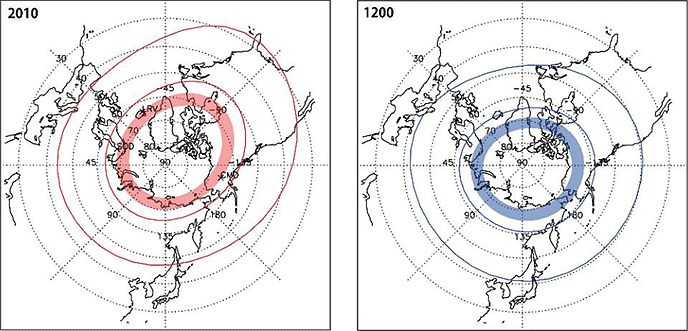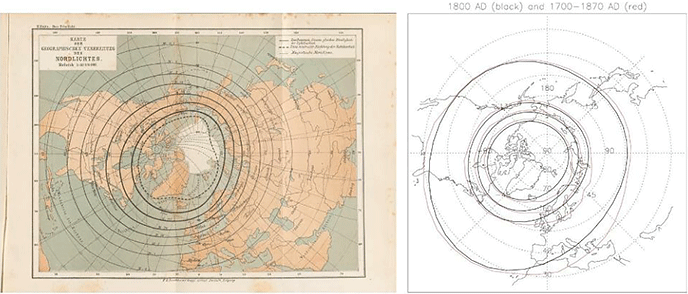
Why the discrepancy? Researchers set out to better understand the auroral zone and its movement over the last 3,000 years in an effort to predict how it might change in the future. The team published maps indicating how the auroral zone has moved over the last three millennia on Aug. 20 in the Journal of Space Weather and Space Climate.
"The accurate knowledge of the auroral zone over the past 3,000 years — via worldwide old witness record of auroras, including those even from low-latitude Japan — helps us understand the extreme magnetic storms," said first author Ryuho Kataoka, associate professor at the National Institute of Polar Research.
The researchers used the latest models of paleomagnetism, which can estimate Earth's magnetic field in history by examining magnetic evidence contained in rocks, to map the auroral zone. Most auroras occur in a band roughly 20 to 30 degrees from the planet's magnetic poles. The band is an oval, according to Kataoka, that can sporadically expand toward middle-latitude regions, such as Japan, during extreme magnetic storms.
"The auroral zone changes over time, and the deformation and sporadic expansion of the auroral oval are recorded in historical documents over a thousand years from across the world," Kataoka said.
For example, the map of the auroral zone in the 11th to 12th century indicates a notch up from over Norway, where "The Poetic Edda" originated, but a dip toward Japan at the same time. The next century, the auroral zone started moving away from Japan but settled over Greenland. The historical literature matches the paleomagnetism records, according to Kataoka.
The researchers also found similar consistencies in witness accounts in the United Kingdom during the 18th century, matching how the auroral zone dipped over Europe.

Right: Reconstructed auroral zone in 1800 AD (black) and possible deformation by a 170-year integration for the time interval between 1700 AD and 1870 AD (red).
The researchers are now exploring how to use their maps to predict how the auroral zone may behave in the future, to help avoid potentially negative effects on worldwide power grids.
The paper was co-authored by Shin'ya Nakano, associate professor at The Institute of Statistical Mathematics and the Center for Data Assimilation Research and Applications, Joint Support Center for Data Science Research. Both Kataoka and Nakano are also affiliated with the Graduate University for Advanced Studies (SOKENDAI).
Original article:
Journal: Journal of Space Weather and Space Climate
Title: Auroral zone over the last 3000 years
Authors: Ryuho Kataoka (National Institute of Polar Research, Japan) & Shin'ya Nakano (the Institute of Statistical Mathematics, Japan)
DOI: 10.1051/swsc/2021030
Published Online: August 20, 2021



Reader Comments
to our Newsletter